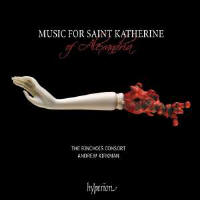Texte paru dans: / Appeared in: |
|
|
Reviewer: J.
F. Weber
This collection of
15th-century English music demonstrates the widespread devotion to the early
Christian martyr St. Catherine of Alexandria, after whose manner of torture
the Catherine wheel is named. (According to legend, the wheel was destroyed
and she was then beheaded.) The notes recount extensively the development of
her cult as it moved from the East to the West in the Middle Ages. It is no
longer observed liturgically, like other popular but legendary saints such
as St. Christopher, St. George, and St. Philomena. The marriage of Henry V
to the Valois princess Kate increased her popularity greatly. (Shades of the
present day, though the saint is no longer remembered in the same way.)
Apart from the Blessed Virgin, no other saint has been honored with enough
15th-century music to fill a CD, as the notes aptly point out. Featured is
Walter Frye’s Mass, using a cantus firmus taken from Nobilis et pulchra,
the first matins responsory for the saint. The cantus firmus itself is also
sung enhanced with faburden. Dunstaple’s Salve scema sanctitatis is
based on Virgo flagellatur, the sixth Matins responsory; that cantus
firmus also underlies an anonymous Gloria, and the cantus firmus is also
sung enhanced with faburden. Byttering’s En Katerine solennia is
based on the verse of the same responsory. Gaude virgo Katherina is a
sequence that seems to be a first recording. | |
|
|
|
|
|
|
|
Cliquez l'un ou l'autre
bouton pour découvrir bien d'autres critiques de CD |
|




